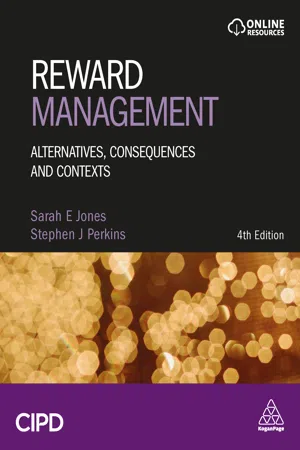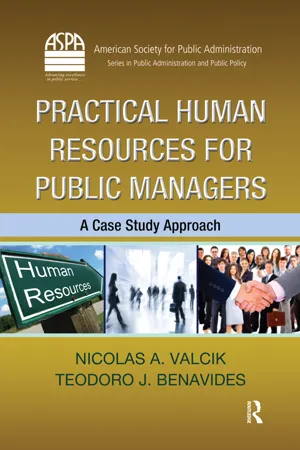Employee Benefits
Employee benefits are non-wage compensations provided to employees in addition to their regular salary or wages. These benefits can include health insurance, retirement plans, paid time off, and other perks such as wellness programs or tuition reimbursement. Offering attractive employee benefits can help businesses attract and retain top talent, as well as improve overall employee satisfaction and well-being.
8 Key excerpts on "Employee Benefits"
- eBook - ePub
The Reward Management Toolkit
A Step-By-Step Guide to Designing and Delivering Pay and Benefits
- Michael Armstrong, Ann Chapman(Authors)
- 2011(Publication Date)
- Kogan Page(Publisher)
...Tool 12 Employee Benefits Introduction Employee Benefits consist of arrangements made by employers for their employees that enhance the latters’ well-being. They are provided in addition to pay and form important elements of the total reward package. As part of total remuneration, they may be deferred or contingent, like a pension scheme, insurance cover or sick pay, or they may be immediate, like a company car or a loan. Employee Benefits also include holidays and leave arrangements that are part of an employee’s terms and conditions of employment but not strictly remuneration. Some benefits are referred to as ‘perks’ (perquisites) or ‘fringe benefits’, but usually only those benefits that extend beyond the core pensions and health benefits, most typically to senior executives. Employee Benefits are a costly part of the remuneration package. They can amount to one-third or more of basic pay costs and therefore have to be planned and managed with care. But they are not all equally wanted or appreciated by the staff that receive them and, from the employer’s point of view, some benefits will therefore not provide value for money. This issue can be addressed by the introduction of flexible benefits as described in this tool. Note that many benefits such as company cars, interest-free loans, private medical insurance, and prizes, gifts and vouchers are taxable. It is worth seeking advice from a tax specialist if in any doubt. Purpose and contents of the tool The considerable expense, not to speak of the time and trouble, that can be involved in providing Employee Benefits, and the fact that they are often under-appreciated and underused, makes it imperative to be clear about what the organization is trying to achieve, ie its employee benefit objectives, and to review the effectiveness of its Employee Benefits policies and practices against those objectives. The purpose of this tool is to provide guidance on methods of doing this...
- eBook - ePub
The WorldatWork Handbook of Compensation, Benefits and Total Rewards
A Comprehensive Guide for HR Professionals
- (Author)
- 2015(Publication Date)
- Wiley(Publisher)
...17 Employee Benefits Basics To attract, motivate, and retain good workers, companies need to define what an employee wants from the employment relationship. One way to define employee needs is to consider “total rewards,” which are everything an employee perceives to be of value resulting from working for the company. Benefits are a core element of the WorldatWork total rewards model. (See Figure 1.3 in Chapter 1.) Benefits include health and welfare plans and retirement plans designed to help protect and ensure employees’ financial security, as well as programs providing pay for time not worked. Over a period of time, Employee Benefits have evolved from basic “fringe benefits” of insurance coverage and a few perquisites to a comprehensive range of benefits that strike a balance between employees’ personal and professional lives. The ever-growing package of offerings has evolved, along with some compensation programs, into a separate element of the total rewards model, work-life. Can some programs of work-life be considered benefits? Yes, many organizations still consider them benefits. The total rewards model takes into account the fluidity of the relationship between compensation, benefits, and work-life. It will be up to each individual organization to define precisely where the various programs will be categorized. HISTORICAL PERSPECTIVE OF BENEFITS The world of Employee Benefits is drastically different than just 5 years ago, let alone 15 to 20 years ago. What is not new is that employees need benefits and companies need employees. However, due to the escalation of benefit costs, employers have started to re-examine the employees ’ role in the selection, payment, and management of benefits. FIGURE 17.1 Historical influences–the benefits timeline. Historically, employers handled all aspects of benefits. This was the era of providing “cradle to grave” benefits. Employers selected and paid for benefits...
- eBook - ePub
Reward Management
Alternatives, Consequences and Contexts
- Stephen J Perkins, Sarah Jones(Authors)
- 2020(Publication Date)
- CIPD - Kogan Page(Publisher)
...Both developments reflect wider changes in society. There has also been increasing employer concern about the escalating costs of such benefits (especially, but not solely, in the USA) and a perception that employees do not recognise the value of what is on offer but take such benefits for granted. This in turn has led to both a ‘budget’ approach to benefits based on the concepts of flexibility and choice and to an increasing emphasis on the ‘total reward’ concept (see Chapter 9), by which employers talk about the value of the whole pay and benefits package. This has shifted the rationale of many employers’ benefits policies from an emphasis on the welfare ‘safety net’ nature of the benefit to an emphasis on the ‘value for money’ approach. Increasingly, employers are seeking to discover whether benefits can play a more strategic role in wider human resource policy, such as recruitment, retention, motivation and performance. On the other hand, legislation is also playing an increasing role in defining both the content and the boundaries for Employee Benefits. DEFINITION Employee Benefits or ‘fringe benefits’ form part of remuneration and consist of a broad range of additions to an employee’s income. An important function of benefits is to provide for employee security in the event of disruption to regular earnings, while in other cases benefits may confer status or serve as an aid to recruitment and retention. (Heery and Noon, 2017) 7.2 An absence of theory Many employers view benefits as a key part of employment contract, and a number of objectives are often mentioned as the explanation. For example, Armstrong and Murlis (2007) argue that benefits increase commitment, provide for the actual or perceived personal needs of employees, demonstrate a ‘good employer’ image, attract and retain staff, and provide a tax-efficient method of remunerating staff...
- eBook - ePub
- William J. Rothwell, William J. Rothwell(Authors)
- 2012(Publication Date)
- Pfeiffer(Publisher)
...ARTICLE 39 FLEXIBLE BENEFITS Maurie Caitlin Kelly The term “Employee Benefits” describes a form of indirect compensation offered to employees by employers in addition to regular wage or salary compensation (Rosenbloom, 1996). Flexible benefits are an approach to Employee Benefits in which the employer provides the employee with the ability to select and customize the components of his or her benefit package from a predetermined set of offerings from the employer. Flexible benefits have become progressively more common in the approach to employee compensation offered by both large and small employers. By 1995, studies showed that over one-third of employers provided some form of flexibility in employee compensation plans (Barringer & Milkovich, 1998). In addition, a study done during the same period reported that 73 percent of Fortune 1000 firms offered flexible benefit plans (Ledford, Lawler, & Mohrman, 1995). However, these plans can be significantly more costly than providing a single plan for all employees (Weathington, 2008). The evolution of flexible benefits spans workplace history from early fringe benefits to the now more complex employee choice benefit plans. The growth of flexible benefit plans not only reflects changes in employer attitude but also provides significant insight into our evolving work environment and the evolution of our society. Background Employee benefit plans have evolved dramatically in the past fifty years, in particular with the addition of flexible benefits. Flexible benefits, also known as cafeteria plans or employee choice plans, differ from standard Employee Benefits or fringe benefits in that they allow the employee flexibility to customize his or her benefit package (Bloom & Trahan, 1986)...
- eBook - ePub
Practical Human Resources for Public Managers
A Case Study Approach
- Nicolas A. Valcik, Teodoro J. Benavides(Authors)
- 2017(Publication Date)
- Routledge(Publisher)
...Chapter 9 Employee Benefits To remain competitive when recruiting and retaining personnel, public entities must provide benefits for employees and their families. The types of nonwage benefits vary among public organizations but usually consist of retirement plans, medical insurance, dental and vision plans, disability insurance, life insurance, paid time off, worker compensation programs, and domestic partner benefits. Fringe benefits can include tuition assistance, flexible medical or child care benefits, and performance pay. Medical Insurance Medical insurance covers the costs of physician and surgeon fees, hospital rooms, and prescription drugs. Dental and optical care might also be offered as part of an overall package, as separate benefits, or not covered at all. Coverage can sometimes include the employee’s dependents. Medical coverage is generally provided through managed health care plans. The most common types of managed health care plans are health maintenance organizations (HMOs) and preferred provider organizations (PPOs). Managed health care plans enter into contracts with doctors, hospitals, clinics, and other health care providers such as pharmacies, labs, x-ray centers, and medical equipment vendors. This group of contracted health care providers is known as the health plan’s network. In some types of managed health care plans, an employee may be required to receive all health care services from a network provider. In other managed health care plans, an employee may be able to receive care from providers who are not part of the network but will pay a larger share of the cost to receive these services. In an HMO, employees and their dependents receive most or all health care from a network provider. HMOs require that the employee selects one primary care physician who is responsible for managing and coordinating all of their health care...
- eBook - ePub
- Bruce Mackenzie, Allan Lombard, Danie Coetsee, Tapiwa Njikizana, Raymond Chamboko(Authors)
- 2010(Publication Date)
- Wiley(Publisher)
...20 Employee Benefits Scope Definitions General Recognition Principle Short-term Employee Benefits Post-employment Benefit Classification Multi-employer Plans and State Plans Insured Benefits Defined Contribution Plans Defined Benefit Plans Other Long-term Employee Benefits Termination Benefits Group Plans Differences between IFRS for SMEs and Full IFRS Differences from Exposure Draft Summary SCOPE The Standard provides guidance on how to account for the consideration given by an entity to its employees in return for their service. All benefits provided to employees are covered under this chapter with the exception of share-based payment transactions, which are dealt with in terms of Chapter 19 on Share-Based Payment. DEFINITIONS Employee Benefits are made up of four types of remuneration, which are defined in the Standard as illustrated in Exhibit 20.1. Exhibit 20.1 Classification of Employee Benefits Short-term Employee Benefits Short-term Employee Benefits are Employee Benefits (other than termination benefits) that are wholly due within 12 months after the reporting date in which the employees render the related service. Short-term benefits generally consist of such items as: Salaries and wages Canteen subsidies Leave pay Medical aid contributions Social security contributions Pension contributions Other fringe benefits (such as access to the use of free or subsidized entity assets, e.g., vehicles, accommodation, goods, and services) Short-term benefits, as defined, do not include any costs relating to the termination of the employees’ contracts of employment with the entity. Post-employment Benefits Post-employment benefits are Employee Benefits (other than termination benefits) that are payable after the completion of employment. Post-employment benefits may include the following: Retirement benefits such as pensions Other benefits such as continued...
- eBook - ePub
Industrial Relations to Human Resources and Beyond: The Evolving Process of Employee Relations Management
The Evolving Process of Employee Relations Management
- Bruce E. Kaufman, Richard A. Beaumont, Roy B. Helfgott(Authors)
- 2016(Publication Date)
- Routledge(Publisher)
...6 Employee Benefits and Social Insurance The Welfare Side of Employee Relations John F. Burton, Jr., and Daniel J.B. Mitchell DOI: 10.4324/9781315498331-8 Introduction The primary purpose of this chapter is to examine the role of employers in the development and evolution of Employee Benefits and social insurance during the twentieth century. 1 Employee Benefits voluntarily provided by employers are one component of welfare capitalism, a human resource (HR) strategy that emerged among progressive employers early in the century as a way “to win workers’ cooperation, loyalty, and hard work through positive HR practices, such as above-market pay, job security, Employee Benefits, promotion from within, and employee participation plans,” and to avoid unions and fend off government intervention in labor markets (Kaufman 2001). Because employer-provided benefits are often competitive with or complementary to social insurance (benefits for workers provided by insurance arrangements operated or mandated by government), we also examine the history of social insurance. Table 6.1, which provides data from the National Income and Product Accounts (NIPA) on employer-paid Employee Benefits and employer contributions for social insurance, 2 illustrates the enormous growth of these expenditures in the twentieth century. In 1929, Employee Benefits and social insurance represented 1.3 percent of wages and salaries; by 2000, these employer expenditures had increased to 18.2 percent of payroll. 3 Table 6.1 Employee Com pensation and Components, 1929—2000 Other labor income (Employee Benefits) Wages and salaries Employer contribution for social insurance Compensation Year $ Billions $ Billions As % of wages and salaries $ Billions As % of wages and salaries $ Billions As % of wages and...
- eBook - ePub
Make More Money Now
Negotiate salary with charisma & rhetoric, learn to sell, anti-stress strategies & resilience for financial freedom, invest intelligently, reach wealth goals
- Simone Janson, Simone Janson, Simone Janson(Authors)
- 2024(Publication Date)
- Best of HR – Berufebilder.de®(Publisher)
...Some companies have even started to set up their own day care centers. Mobility: Being mobile at the expense of the company - why not? Especially the company car is still popular. In cities, a model gains in importance: the speech is from the service bicycle. The latter is often just as fast as the car and the healthier alternative. securities: This benefit has found its way from the USA to Germany. Some companies give their employees a small share package each year. Anyone who has been with the company for many years, thus comes to a decent volume of securities. Sometimes these packages are worth more than a whole year's salary. What extra benefits are there? Discounted own products and cheap tickets in local transport for public transport employees are two examples of internal benefits. But even outside the company, employees can benefit from benefits. For example, some companies offer the payment of benefits on a prepaid credit card. Although this is then no longer completely tax-free, but may be cheaper than the current salary payment. Benefits for certain occupational groups In addition, benefits may also result from employees belonging to a particular occupational group. The best example here are certainly officials who often find it easier to get a loan. Due to the non-cancellability of their job, the conditions are often discounted. Here, however, caution is required : Some formerly licensed professions, such as postmen, are now part of the normal private sector. For them, corresponding benefits no longer apply, but the terms are just like all borrowers simply determined by the credit rating. And the health of employees can also be turned into benefits. Companies can spend a certain sum on health management per year. No one has claimed that these can not be vouchers for a gym or something similar. Benefits by size of the farm Business benefits sweeten the signature under the employment contract...







